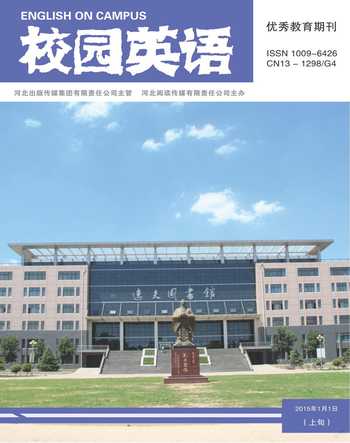Positive Transfer of Native Language in English Learning
2015-05-30邹强珍
邹强珍
【Abstract】The role of speakers native language (NL) in the process of second language learning has been a controversial focus among researchers.For decades researchers generally considered speakers NL as a kind of interference, or negative transfer in second language acquisition (SLA).Recent studies, however, have proved the positive effect of NL.In this paper the writer attempts to explores the positive impact of Chinese on English learning
【Key Words】positive transfer; native language (NL); second language acquisition (SLA)
1.Introduction
Most linguists have recognized that ones native language (NL) will influence his second language acquisition (SLA).This is because before a speaker learns a second language his mind is not a blank state but has already processed systematic knowledge of his mother tongue.Therefore, the speaker, who has already formed the habit of thinking in his native language, will no doubt be influenced by it when he learns a second language.This is so-called language transfer which is also well-known as cross-linguistic influence.Language transfer is an important factor influencing the second language learning.It is one of the conceptions in psychology.Transfer refers to the influence because of similarities and differences between the target language (that needs learning) and native language.This kind of influence can be divided into positive transfer and interference (negative transfer).Both of them should be paid attention to in the study of cross-linguistic influences.The present paper mainly explores the positive impact of Chinese on English learning.
2.Positive Transfer
Speakers native language can facilitate the target language learning.This phenomenon often happens when ones native language and target language are similar in some aspects.So when learning these aspects, the old principles of NL can be applied in the process of SLA and the learning process will be simpler.We call this positive transfer.
3.Positive Impact of Chinese on English Learning
Language is the arbitrary vocal sign for human communication.In this sense all the languages serve the same function, and what distinct them lies in the form outside.So to some extent it is true for L2.SLA and foreign language teaching base themselves on NL, and previous knowledge of NL is helpful in SLA.Here the positive influence of our tongue can be explained from 3 aspects: phonetics, lexicology and grammar.
3.1 Phonetics
The positive influences of the native language play an important role when learners study a new phonetic system.For example, the English consonants /b/, /d/, /g/, etc have almost the same manners of articulation and places of obstruction as Chinese Pinyin, “b”, “d”, and “g”.So when learners study these consonants its very easy for Chinese students to acquire them.The 4 tones of Chinese characters are like the stresses of English words.If learners cant pronounce the tones correctly, it will influence the modulation of the sentence or cause ambiguity.So do the stresses of English words.
3.2 Lexicology
The positive transfer of the native language also plays a vital role in foreign vocabulary acquisition of learners.When teaching English words, many teachers like to explain them in English.For example, a teacher explains the word “computer” like this: an electronic calculating at very high speed.Though the teacher repeats the explanation for several times, the learners might get confused and couldnt understand the meaning.If the Chinese correspondent “jisuan ji” (计算机) is employed here, the learner will realize all of a sudden.Michael Swan referred the same phenomenon, too.
3.3 Grammar
With the enlightenment of transformational-generative grammar of Chomsky, grammar in all languages has similarities such as expressing negating, question and causality.And some languages, such as English and Chinese, do have similarities here, especially in syntax field, for example:
(1) S – Link verb – O: they are students.(他们是学生。)
(2) S – V – O: Tom likes books.(汤姆喜欢看书。)
(3) S – V – C – C: I found the book very boring.(我发现这本书很无聊。)
(4) S – V – O – O: Mother gave me a bike.(妈妈给我一辆自行车。)
From the examples we can see the order of these sentences in English and Chinese are almost the same.Learners may translate them directly without changing the word order.Therefore, when we learn these sentence structures, if we can turn back to our NL, it could help us confirm our memory and understanding.Learners can express themselves freely in English as long as they pay much attention to the different forms of English verbs.
4.Conclusion
The major concern of this paper is to discuss the positive influence of NL on SLA and thus throw some enlightenment on teaching, confirming that translation method does have its beneficial side.
Translation is a useful language-teaching tool in second language teaching.By comparing students mother tongue and target language from aspects of grammar, vocabulary, word order and other language points they can understand the target language more deeply and clearly.It is evident to demonstrate that translation in the classroom can aid learners in their studies and they can benefit a lot from translation both in class and in second language writing.
Reference:
[1]Brown, H.D, Principles of Language Learning and Teaching.Englewood Cliffs, NJ: Prentice Hall Regents, 1994.
*本文是陕西省教育科学“十二五”规划2014年度课题 “地方高师院校学生英语口语自主学习能力培养途径及课堂教学模式研究”(项目编号:SGH140816)和陕西省教育厅2014年科研项目 “新课标下农村中小学英语教师多元化培训模式建构研究”(项目编号:14JK1792)的阶段性成果。
